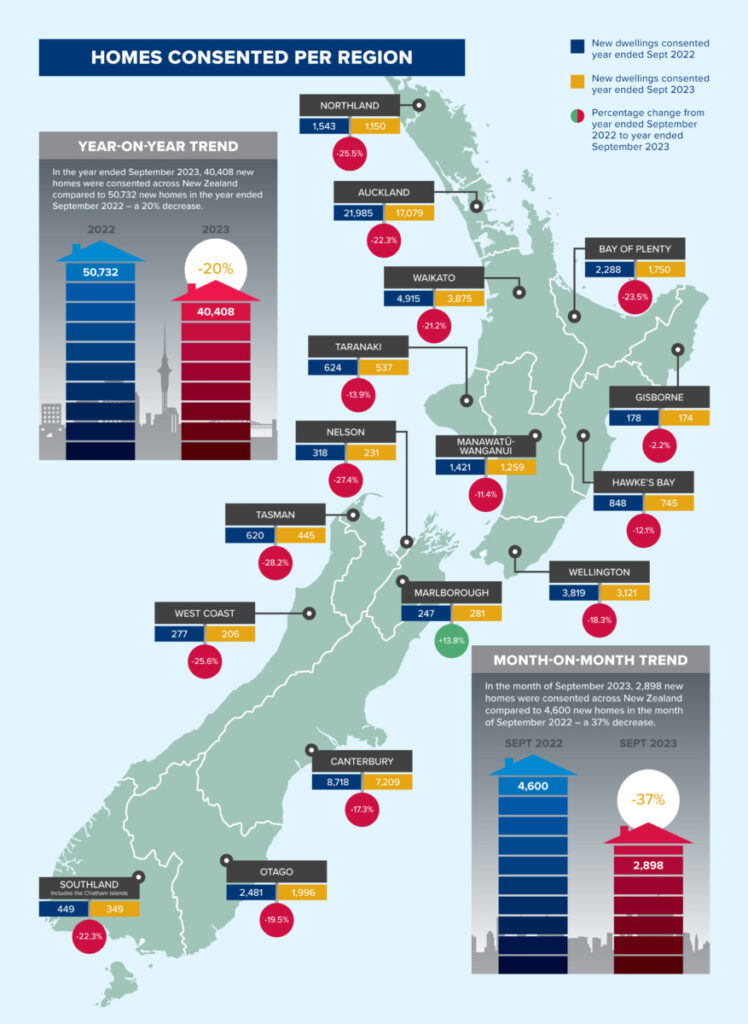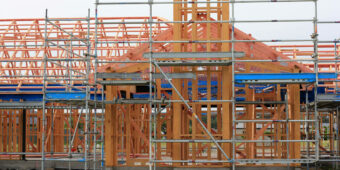September consents drop 20%
29 Nov 2023, Industry News, News

The year ended September 2023 saw consents drop by a fifth, although the number of new homes consented in that period remains high within a wider historical context
In the year ended September 2023, 40,408 new homes were consented – 20% less than in the same period the previous year. Of the new homes consented, there were 23,789 multi-unit homes (-15% compared with the year ended September 2022) and 16,619 stand-alone houses (-27%). Of the multi-unit homes, 17,874 were townhouses, flats and units (-14%), 3,227 apartments (-26%) and 2,688 retirement village units (-6.8%).
While the figures represent declines across the board, Construction and Property Statistics Manager Michael Heslop said that when looked at through a historical lens, activity was still high.
“The annual number of new homes consented has continued to decrease from its peak of 51,015 in the year ended May 2022.
“However, the number of new homes consented in the year ended September 2023 is still at a higher level than any 12-month period prior to 2021.”
In seasonally adjusted terms, the number of new homes consented in the September 2023 quarter fell 12% compared with the September 2022 quarter, following a 3.9% seasonally adjusted fall in the September 2023 quarter.
Monthly consents down a third
There were 2,898 new homes consented in the month September 2023 – a drop of 37% compared to the month of September 2022, which consented 4,600 new dwellings.
In September 2023, there were 1,200 stand-alone homes consented; a 24% reduction compared to September 2022, which consented 1,848 stand-alone homes. There was also a 45% reduction in the amount of multi-unit homes consented from 2,752 to 1,494.
Only one region consented more dwellings in the year ended September 2023 compared to the previous year as Marlborough (281 vs 247) bucked nationwide trends.
The four regions with the most consents issued were Auckland (17,079; -22%), Canterbury (7,209; -17%) Waikato (3,875; -21%) and Wellington (3,121; -18%), which all experienced declines compared with the year ended September 2022.
Consents per 1,000 remain strong
In terms of dwellings consented per 1,000 residents, the figures for the year ended September 2023 (7.8) declined compared with the year ended September 2022 (9.9) but remained strong when looked at over a period of 57 years, said Heslop.
“Although the number of new homes consented per 1000 residents has fallen in the year ended September 2023, it is still higher than the historical average of 6.7,” Heslop said.
Between 1966 and 2023, the average number of homes consented per 1,000 residents was 6.7 and the record number of new dwellings consented per 1,000 residents was 13.4 in the year ended December 1973.
One region bucks the trend
Only one region – Marlborough (5.4; up from 4.8) – consented more dwellings per 1,000 residents in the year ended September 2023 compared to the year ended September 2022.
Canterbury (10.8; down from 13.3) and Auckland (9.8; down from 13) maintained above-average levels of consents per 1,000 residents, despite experiencing downward trends.
“The number of new homes consented per 1,000 residents can be higher in popular holiday areas, as holidaymakers and tourists are excluded from the estimated resident population,” Heslop added.
“But some of the places they stay, such as holiday homes, are included in the number of homes consented.”
Non-residential building consents up
In the year ended September 2023, non-residential building consents totalled $9.8bn, up 3.9% from the year ended September 2022. The building types with the highest value were:
- Hospitals, nursing homes, and health buildings – $1.5bn (+11%).
- Offices, administration and public transport buildings – $1.5bn (-5.3%).
- Storage buildings – $1.5bn (-2.6%).

Register to earn LBP Points Sign in



